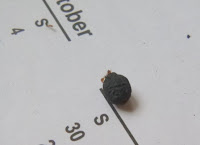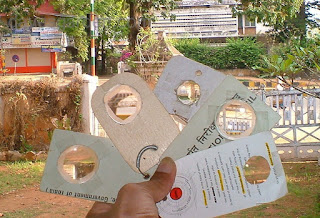Living opposite our house on Devaparthiva Road, was one humble Iyer family. Ramaswamy Iyer and his wife had five children. The third one was Ganapathi, a boy slightly elder to me. He was a very talented chap and my nemesis in many games we used to play against each other. How we used to play several games and created little toys with innocuous materials can cause wonderment today, in the world of iPads, cell phones, laptops.
The Iyer family lived in the [rented] house seen with a green door at the back. Our tenant enters our premise. Photo may be from 2001 or so. The houses have undergone facelift since the 60s. We no longer live in this street. The Iyer family left in the early 70s. The opposite row of houses had a common wall between them!
 Ganapathi was an expert player in tops. His played with a narrow design top. His rope was unique. It was short and stout, which he himself had made it using other threads. The length was so short that he would wind it in a jiffy, spin and lift it into the hand circling with the rope while still spinning. His swiftness coupled with the shortness of this rope ensured he spun the top a lot earlier than the opponent and hence end up with a win. I would be still winding my long rope [bought from Shetty's shop on Sayyaji Road.] with Ganapathi watching me with a teasing look! Sometimes the tip of my rope would tangle with the pivot nail and this would please him. In another game, the loser would keep his top on the ground in a drawn circle. Others had to hit this top with theirs and spun their top in one action to dislodge it out of the drawn circle. Ganapathi's aim was incredible and he seldom missed the target top. His top's pivot nail was stout and sharp, meant to damage and even break the opponent's top! He would hit very hard and deface it with deep nail marks. He was so accurate in his aim. It was agonizing to see my defaced top but Ganapathi derived great pleasure! He ALWAYS won. He was an undoubted hero of the street.
Ganapathi was an expert player in tops. His played with a narrow design top. His rope was unique. It was short and stout, which he himself had made it using other threads. The length was so short that he would wind it in a jiffy, spin and lift it into the hand circling with the rope while still spinning. His swiftness coupled with the shortness of this rope ensured he spun the top a lot earlier than the opponent and hence end up with a win. I would be still winding my long rope [bought from Shetty's shop on Sayyaji Road.] with Ganapathi watching me with a teasing look! Sometimes the tip of my rope would tangle with the pivot nail and this would please him. In another game, the loser would keep his top on the ground in a drawn circle. Others had to hit this top with theirs and spun their top in one action to dislodge it out of the drawn circle. Ganapathi's aim was incredible and he seldom missed the target top. His top's pivot nail was stout and sharp, meant to damage and even break the opponent's top! He would hit very hard and deface it with deep nail marks. He was so accurate in his aim. It was agonizing to see my defaced top but Ganapathi derived great pleasure! He ALWAYS won. He was an undoubted hero of the street.
A top from those days, cracked by time and not by Ganapathi. This is nearly how his top was like.
Only a few of these marbles are from those times, the roughened ones.
Playing marbles, Ganapathi was very nearly invincible with his laser-sharp aim. He played with his right hand while I was comfortable with my left [middle finger]. He stocked an enviable number of marbles he won in 4-5 beverage tin fulls! It was testimony to his amazing skills. He would proudly show the tin fulls when I went to his house. When he poured the marbles out to show, the very sound of so many marbles was music! I wanted to win like him, but it was impossible with boys like Ganapathi! I would buy marbles, new and shiny, ten marbles for ten paisa at Shetty's shop on Sayyaji Rao Road. Ganapathi used to win most of them! He was dynamic, elder, experienced, bold and talented. He did not cheat, but he loved teasing.
Win he would in the little games with marbles for which matchbox labels were kept at stake. He had bundles of them to show! All the boys lost to him.
At Gulli-danda game, the side in which he was in usually won. In the absence of a Carrom board, he wrote the board with chalk on the floor of his house. His sisters would join the game. It was quite a funny feeling with no 'rebounds' possible! He was good at drawing and he used to show me his sketch book which was stitched from left over pages of old note books. I am sure he would have made that book too.
 There was a game for which we collected empty cigarette packs, folded and piled, kept in a circle and took turns to disperse out of the circle with the striker - a flat piece of stone - to win. Ganapathi would hit the target unerringly and grab all at stake kept in the circle! Seldom did he miss. At the game of Lagori also he was very good.
There was a game for which we collected empty cigarette packs, folded and piled, kept in a circle and took turns to disperse out of the circle with the striker - a flat piece of stone - to win. Ganapathi would hit the target unerringly and grab all at stake kept in the circle! Seldom did he miss. At the game of Lagori also he was very good.
Ganapathi was adept in whistling with the fingers in different styles. He would also make a few types with ordinary things like some bamboo pieces and bicycle tube rubber. He had made a beautiful slingshot with which he would hit the target, usually some fruit or for fun with such aim that was truly astonishing.
 Among the many other little things like those, the one thing I still admire was his ingenuity in making a 'pea whistle'. A real pea whistle would be like this, used by army officers, the police and sports masters.
Among the many other little things like those, the one thing I still admire was his ingenuity in making a 'pea whistle'. A real pea whistle would be like this, used by army officers, the police and sports masters.
Our genius Ganapathy made his own from real scrap. It was crude, but it worked... 'prrrreeeep... prrrrrreeeeeep'. I tried to recall by trying to replicate the whistle 42-43 years since I saw Ganapathi's work. I remember I had made one at that time also. We needed an old wall calendar with its pages bound like this - with a thin tin strip. In those days, this was the only type we had and the spring bound calendars had not arrived.
 There was a game for which we collected empty cigarette packs, folded and piled, kept in a circle and took turns to disperse out of the circle with the striker - a flat piece of stone - to win. Ganapathi would hit the target unerringly and grab all at stake kept in the circle! Seldom did he miss. At the game of Lagori also he was very good.
There was a game for which we collected empty cigarette packs, folded and piled, kept in a circle and took turns to disperse out of the circle with the striker - a flat piece of stone - to win. Ganapathi would hit the target unerringly and grab all at stake kept in the circle! Seldom did he miss. At the game of Lagori also he was very good.Ganapathi was adept in whistling with the fingers in different styles. He would also make a few types with ordinary things like some bamboo pieces and bicycle tube rubber. He had made a beautiful slingshot with which he would hit the target, usually some fruit or for fun with such aim that was truly astonishing.
 Among the many other little things like those, the one thing I still admire was his ingenuity in making a 'pea whistle'. A real pea whistle would be like this, used by army officers, the police and sports masters.
Among the many other little things like those, the one thing I still admire was his ingenuity in making a 'pea whistle'. A real pea whistle would be like this, used by army officers, the police and sports masters.Our genius Ganapathy made his own from real scrap. It was crude, but it worked... 'prrrreeeep... prrrrrreeeeeep'. I tried to recall by trying to replicate the whistle 42-43 years since I saw Ganapathi's work. I remember I had made one at that time also. We needed an old wall calendar with its pages bound like this - with a thin tin strip. In those days, this was the only type we had and the spring bound calendars had not arrived.
Unfold the tin strip and separate from the calendar paper. Just a length of about 4-5 inches is all that is required to make the whistle.
Flatten this portion, cut it.
Bend the piece like this.
I do not know how Ganapathi made this air-escape hole, but I punched the hole with a poker and flattened it.
The 'mouth piece' which I had slightly rounded to blow air in was wrapped with paper to prevent air leakage from the sides. Again, I cannot recall clearly how our genius used to make. I bent slightly at the hole for the blown air to enter the curved area that would house the 'whirring' seed. The open sides were held closed by the thumb and another fingertip after putting the 'seed' in it.
Ganapathi used a star gooseberry seed but I found a Mirabilis jalapa plant seed [below] in my garden to serve the purpose.
Ganapathi's whistle made a pleasing little 'prrrrreeeeep'. The seed had to be saved each time we removed the fingers from the whistle. My latest project whistle produced 'Ssrrrssssrrrsssssss'. Do not miss the 'r' that is the sound produced by the blown seed trapped in the gap, I need to adjust the angle of the air blow and I am sure to re-tune the true 'prrreeeeepp' some time.
But then this is just for the idea how our genius Ganapathi did from things that one expected!































